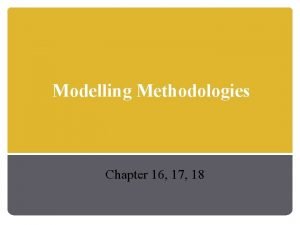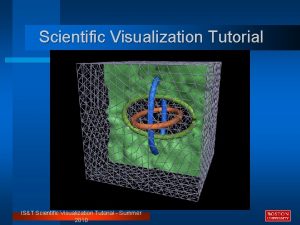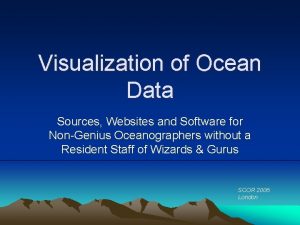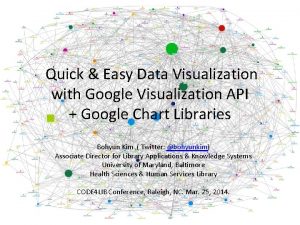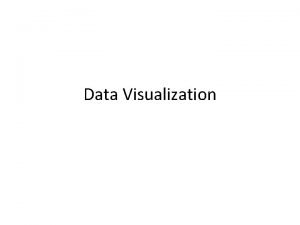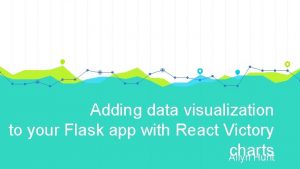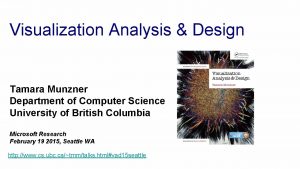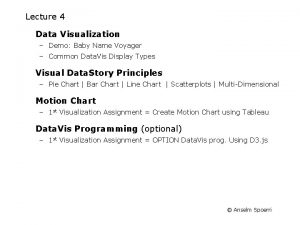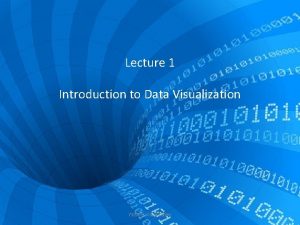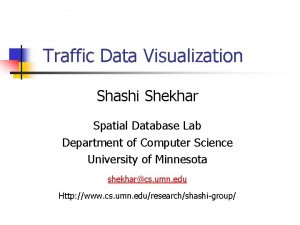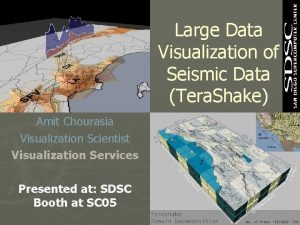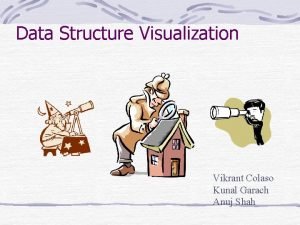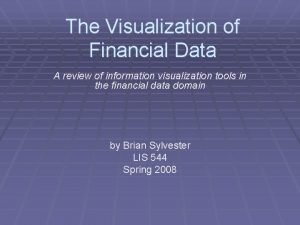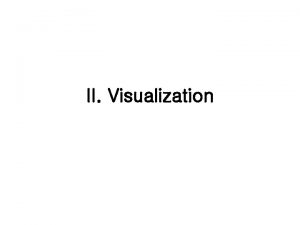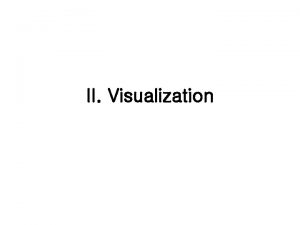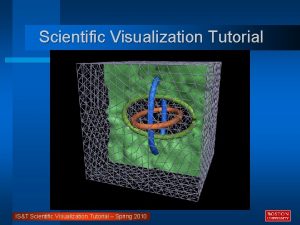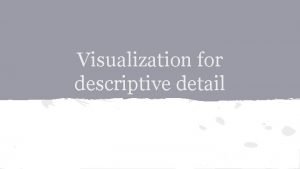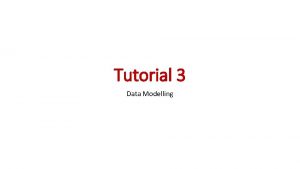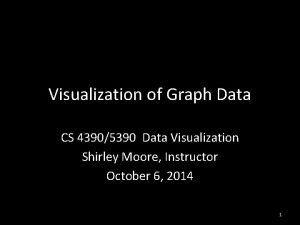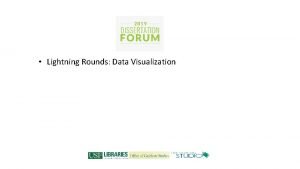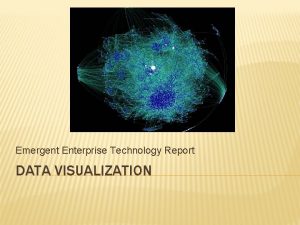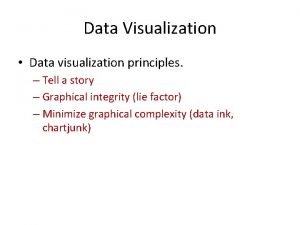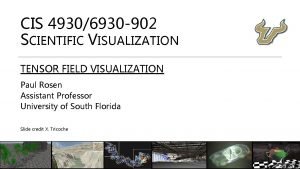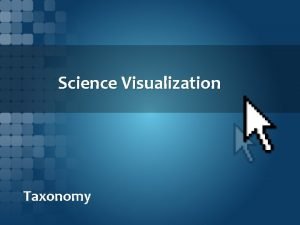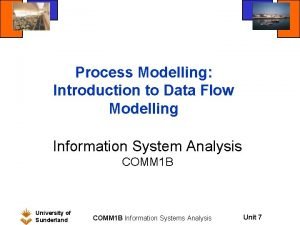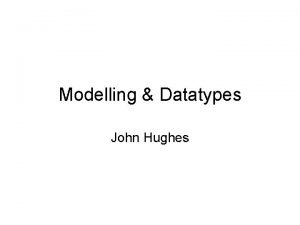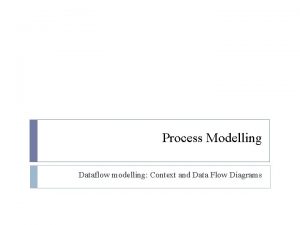Scientific Visualization Data Modelling for Scientific Visualization CS



































- Slides: 35

Scientific Visualization Data Modelling for Scientific Visualization CS 5630 / 6630 August 28, 2007

Recap: The Vis Pipeline

Recap: The Vis Pipeline

Types of Data in Sci. Vis: Functions http: //lambda. gsfc. nasa. gov/product/cobe/firas_image. cfm

Types of Data in Sci. Vis: Functions on Circles E. Anderson et al. : Towards Development of a Circuit Based Treatment for Impaired Memory

Types of Data in Sci. Vis: 2 D Scalar Fields

Types of Data in Sci. Vis: Scalar Fields on Spheres http: //lambda. gsfc. nasa. gov/product/cobe/firas_image. cfm

Types of Data in Sci. Vis: 3 D, time-varying Scalar Fields http: //background. uchicago. edu/~whu/beginners/introduction. html

Types of Data in Sci. Vis: 2 D Vector Fields

Types of Data in Sci. Vis: 3 D Vector Fields

Tensors are “multilinear functions” rank 0 tensors are scalars rank 1 tensors are vectors rank 2 tensors are matrices, which transform vectors rank 3. . n tensors have no nice name, but they transform matrices, rank-3 tensors, etc. We are not going to see these

DTI Tensors are symmetric, positive definite SPD: scale along orthogonal directions More specifically, they approximate the rate of directional water diffusion in tissue

Types of Data in Sci. Vis: 2 D, 3 D Tensor Fields Kindlmann et al. Super-Quadric Tensor Glyphs and Glyph-packing for DTI vis.

Computers like discrete data, but world is continuous

Sampling Continuous to discrete Store properties at a finite set of points

Sampling Continuous to discrete Store properties at a finite set of points

Sampling Continuous to discrete Store properties at a finite set of points

Interpolation Discrete to continuous Reconstruct the illusion of continuous data, using finite computation

Nearest Neighbor Interpolation Pick the closest value to you

Linear Interpolation Assume function is linear between two samples

Linear Interpolation Assume function is linear between two samples f(x) = ax + b v 1 = a. 0 + b = b v 2 = a. 1 + b = a + b b = v 1 a = v 2 – b = v 2 - v 1 v 2 f(x) = v 1+ (v 2 – v 1). x 0 u 1 sometimes written as f(x) = v 2. x + v 1. (1 -x)

Cubic Interpolation Linear reconstruction is better than NN, but it is not smooth across sample points Let's use a cubic Two more parameters: we need constraints Constrain derivatives

Cubic Interpolation Same as with linear f(x) = a+b. x+c. x^2+d. x^3 f'(x) = b + 2 cx + 3 dx^2 f(0) = v 1 f(1) = v 2 f'(0) = (v 2 – v 0)/2 f'(1) = (v 3 – v 1)/2 v 3 v 0 v 1 . . . -1 0 1 2 a = v 1 b = (v 2 -v 0) / 2 c = v 0 – 5. v 1/2 + 2 v 2 – v 3/2 d = -v 0/2 + 3. v 1/2 – 3. v 2/2 + v 3/2

(Vis. Trails Demo) Linear vs Higher-order interpolation in plotting

Might make a big difference! Kindlmann et al. Geodesic-loxodromes. . . MICCAI 2007

1 D vs n-D Most common technique: separability Interpolate dimensions one at a time

(Vis. Trails Demo) 2 D Interpolation in VTK images

Implicit vs Explicit Representations Explicit is parametric Domain and range are “explicit” Implicit stores domain. . . implicitly Zero set of a explicit domain Pro: it's easy to change topology of domain: just change the function Con: it's harder to analyze and compute with

Implicit vs. explicit representations Explicit: y(t) = sin(t) x(t) = cos(t) Implicit: f(x, y) = x^2 + y^2 - 1 s = (x(t), y(t)), 0 < t <= 2 s = (x, y): f(x, y) = 0

Regular vs Irregular Data Regular data: sampling on every point of an integer lattice Irregular data: more general sampling

Curvilinear grid Like a regular grid, but on curvilinear coordinates Here, radius and angle

Triangular and Tetrahedral Meshes Completely arbitrary samples Need to store topology: How do samples connect with one another?

Quadrilateral and Hexahedral Meshes Basic element is a quad or a hex Element shape is better for computation Much, much harder to generate

Tabular Data Most common in information visualization Relational DBs

. . . etc. Node vs cell data: do we store values on nodes (vertices) or on cells (tets and tris)? Pure-quad vs quad-dominant: mixing types of elements Linear vs high-order: different interpolation modes on elements
 Task abstraction in data visualization
Task abstraction in data visualization Unit 5 data modelling assignment 2
Unit 5 data modelling assignment 2 Data modelling techniques in business intelligence
Data modelling techniques in business intelligence Modelling relationships and trends in data
Modelling relationships and trends in data Data modelling methodologies
Data modelling methodologies Power platform data modelling
Power platform data modelling Data modelling
Data modelling Photoshop scientific notation
Photoshop scientific notation Ocean data visualization
Ocean data visualization Visage data visualization
Visage data visualization Google visualization api query language
Google visualization api query language Data visualization rules of thumb
Data visualization rules of thumb Lying with data visualization
Lying with data visualization Before and after data visualization
Before and after data visualization Flask data visualization
Flask data visualization Data visualization meetup
Data visualization meetup Data visualization sketch
Data visualization sketch Music data visualization
Music data visualization Visualization analysis and design
Visualization analysis and design Baby name wizard voyager
Baby name wizard voyager Data visualization lecture
Data visualization lecture Heap sort visualization
Heap sort visualization Traffic data visualization
Traffic data visualization Panoramix data visualization
Panoramix data visualization Seismic data visualization
Seismic data visualization Schlieren effect
Schlieren effect Data structure visualization tool
Data structure visualization tool Spotfire demo gallery
Spotfire demo gallery Spotfire vs infozoom
Spotfire vs infozoom Advanced data visualization techniques
Advanced data visualization techniques Kontinuitetshantering i praktiken
Kontinuitetshantering i praktiken Typiska novell drag
Typiska novell drag Tack för att ni lyssnade bild
Tack för att ni lyssnade bild Ekologiskt fotavtryck
Ekologiskt fotavtryck Varför kallas perioden 1918-1939 för mellankrigstiden
Varför kallas perioden 1918-1939 för mellankrigstiden En lathund för arbete med kontinuitetshantering
En lathund för arbete med kontinuitetshantering




